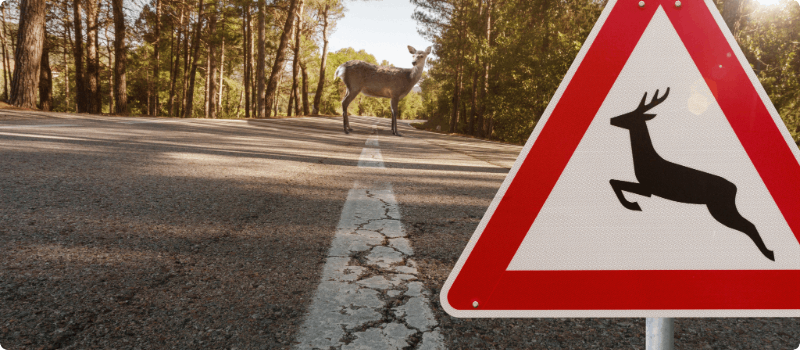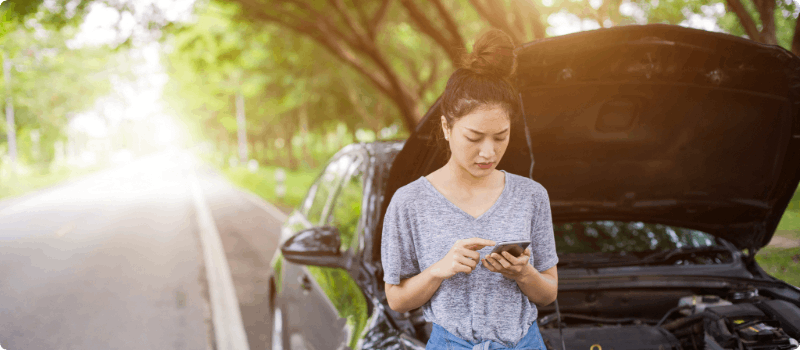What to do if you hit a deer
Updated October 12, 2021 . AmFam Team
It’s always important to be attentive when you’re out on the open road — but deer season calls for drivers to be extra vigilant when behind the wheel. According to the Insurance Information Institute (Opens in a new tab), deer-vehicle collisions are becoming more common, especially from October through December. Deer accidents can be avoided if you know the right steps to prevent it from happening.
So, get your deer goggles on and read more to learn deer driving safety practices for the highway and what to do if you hit a deer while driving.

How to avoid deer collisions
Being prepared and knowing what to do if a deer is in the road is essential to safe driving during deer season. Take a moment to get familiar with some tips to avoid a deer-related collision. Preparation is paramount before you hit the road during deer season.
Make seatbelts a requirement for yourself and every passenger
Seatbelts are designed to protect you from a collision or sudden stop — which is exactly what happens when you’re faced with a deer on the highway. One of the easiest ways to keep you and your family safe is by buckling up.
Be observant of all road signs
Deer crossing signs are there for a reason — to warn you that the area you’re driving in is heavily populated with deer or common areas where deer cross. Be on the lookout and take extra caution when you see these signs. And remember that deer often travel in groups, so where you may only see one, chances are there are more around.
Recruit your passengers to keep a lookout
The more people watching for deer, the better. Tell your passengers to be on the lookout and warn you if they see any deer on the highway or deer crossing road signs. Even if they see deer grazing in fields far from the road, this could potentially mean more deer are around and trying to cross over.
Be aware of the time of day
Dawn and dusk are times deer are most active because it’s when they are commonly on the hunt for food. This is also the time of day when visibility is much lower, and your vision isn’t at its best. So be extra alert during this time of the day.
Prep your horn in case you encounter a deer
Deer often fixate on headlights, so it may not be effective enough to just flash your lights. Since they’re easy to spook, brake firmly and honk your horn.
Don’t swerve to avoid hitting a deer
If it’s apparent that a crash is unavoidable, whether it be a deer or other animal crossing the road, do not swerve. Studies show that more serious crashes occur when drivers swerve to avoid an animal. Swerving could cause you to lose control of your vehicle and possibly roll over or hit another car or object.
Make sure you’re covered with insurance
Although it may not be top-of-mind when thinking about steps to avoid hitting a deer, it’s important to make sure that your auto insurance is up to date.
- Before going on a trip during deer season, consider reaching out to your agent to learn more about your coverage and if you’re covered when a deer accident occurs
- Consider asking your agent about your auto insurance deductible and how it will be impacted if you accidentally hit a deer.

What to do if you hit a deer
While the above precautions may help reduce your chances of a deer accident, unfortunate situations can still occur. So, what happens if you hit a deer? Take action by following these steps.
Get off the road
Be savvy about your safety — move your vehicle off the road after hitting a deer and turn your hazard lights on so other vehicles can see you and slow down.
Should you call the police if you hit a deer?
You may be legally required to report an accident with a deer or significant vehicle damage. Having this information documented can also be helpful when filing a claim with your insurance company.
Take photos
You’ll want to get photos of your car and the accident scene but be careful to stay away from the deer and off the road. A wounded animal can become frightened and act aggressively and lingering close to a road is never a safe idea.
File a claim
The comprehensive coverage on your auto policy covers collisions with an animal, so be sure to get in touch with your insurance company to report a claim.
Since comprehensive is an optional coverage, you may want to check out your policy or connect with an agent to make sure you have the best coverage to protect you in any event. Comprehensive not only covers you for collisions with animals but also other unexpected circumstances like theft, vandalism, hail or other natural disasters, fires or explosions, certain falling objects, and floods.

Protect yourself with comprehensive insurance
Knowing the proper actions to take to avoid hitting a deer can help prevent personal injury and costly vehicle damage, so keep these tips in mind when hitting the road. Give yourself more peace of mind by connecting with your American Family Insurance agent to ensure you have the proper auto coverage to stay protected from the unexpected, such as a deer accident.
This information represents only a brief description of coverages, is not part of your policy, and is not a promise or guarantee of coverage. If there is any conflict between this information and your policy, the provisions of the policy will prevail. Insurance policy terms and conditions may apply. Exclusions may apply to policies, endorsements, or riders. Coverage may vary by state and may be subject to change. Some products are not available in every state. Please read your policy and contact your agent for assistance.
*Customers who bundle home and auto insurance policies may save up to 23% on both policies together (as of December 2023). Discounts may vary by state, property, policy form and company underwriting the home and/or auto policy. Discounts may not apply to all coverages on a home or auto policy.

